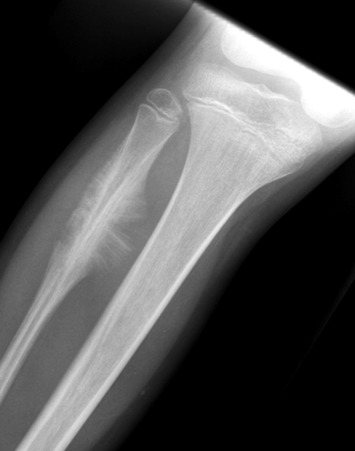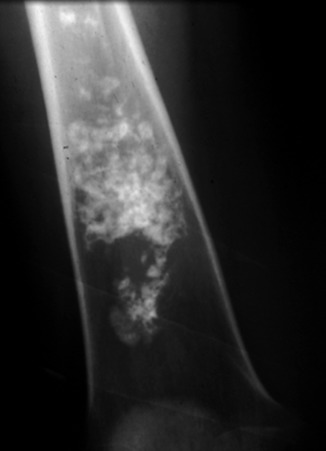Physical Address
304 North Cardinal St.
Dorchester Center, MA 02124
When evaluating a suspected bone tumor, morphologic features, location in a bone (epiphysis, metaphysis, diaphysis), distribution within the skeleton (axial vs. appendicular), presence of tumor matrix, periosteal reaction, and/or presence of a soft tissue mass are considered. Morphologic features to consider are the pattern of bone destruction and the size, shape, margins, and zone of transition of the lesion. A geographic lesion with a sharp border suggests a nonaggressive or benign lesion, whereas a poorly defined margin, especially one associated with cortical destruction, favors malignancy. Periosteal reaction reflects the rate of growth of the underlying lesion. Slow-growing lesions may produce a laminated periosteal reaction with uniform, wavy layers. Malignant lesions that grow in spurts can produce an “onion-skin” pattern, whereas aggressive lesions with rapid growth are associated with a “sunburst” or “hair-on-end” periosteal reaction ( Figure 51-1 ). Codman triangle is the uplifting of the periosteum in a triangular configuration and can be seen with benign and malignant lesions.

Cartilage matrix is typically ringlike, flocculent, or flecklike in the shape of rings and arcs ( Figure 51-2 ), whereas neoplastic bone matrix is typically cloudlike, amorphous, or ivory-like. The detection of tumor matrix can be helpful in recognizing the etiologic factor of the underlying lesion, that is, whether it is osseous or cartilaginous in origin.

Radiographs are the first step in detecting and diagnosing a bone tumor. See Box 51-1 for a list of the radiographic features to assess for bone tumors. Radiographs should also be obtained first with suspected soft tissue tumors to identify possible underlying bone involvement or the presence of calcifications.
Morphologic features and pattern of bone destruction, including zone of transition
Periosteal reaction
Location in the bone and distribution in the skeleton
Presence of tumor matrix
Presence of a soft tissue mass
MRI is the most important diagnostic test for local staging and preoperative planning of primary bone and soft tissue tumors. It is also useful for monitoring the response to chemotherapy or radiation therapy and detecting postoperative tumor recurrence. The use of MRI guidance for biopsy may be considered for lesions that cannot be visualized by any other modality such as a suspected bone marrow lesion. With osteosarcoma, MRI is indicated in the initial workup to evaluate for regional or “skip” metastases in the affected bone, which are frequently radiographically occult.
Contrast enhancement may be used to help distinguish tumor margins and to assess tumor vascularity. It may also help distinguish malignant viable tissue from inflammatory changes and necrosis for preoperative biopsy planning. For a follow-up or post-therapy MRI evaluation, contrast enhancement may be helpful to assess tumor response to chemotherapy, to determine the presence of a fluid collection, and to detect tumor recurrence.
The tumor location, extent, and relationship to the neurovascular bundle and the presence of skip lesions and joint involvement are important features that are assessed with MRI, which help to determine the stage of the tumor and to plan a surgical approach. Although MRI may help in the assessment of the aggressiveness of a lesion and in the recognition of certain “pathognomonic” lesions, it cannot be used to reliably distinguish between benign and malignant tumors and is generally nonspecific in determining tumor cell type. Biopsy of the lesion is often required.
CT may be helpful to detect the nidus in a suspected osteoid osteoma. CT-guided percutaneous cryoablation has been shown to be an effective treatment of osteoid osteoma. CT is also used for percutaneous image-guided biopsy of bone tumors and in the workup for detection of pulmonary metastases. US offers real-time multiplanar imaging for performing musculoskeletal soft tissue biopsies and can be used to guide the biopsy of a bone lesion with an extraosseous soft tissue component. US may be particularly useful for biopsy of small soft tissue lesions that are difficult to detect on a noncontrast CT and also provides real-time confirmation of needle placement. Technetium-99m ( 99m Tc) methylene diphosphonate (MDP) bone scintigraphy with single photon emission computed tomography (SPECT) is often utilized for the detection of osseous metastases. 18 F-fluorodeoxyglucose (FDG) PET/CT may also be used for the detection of metabolically active soft tissue neoplasms or osseous malignancies. Some studies indicate that 18 F-sodium fluoride (NaF) PET/CT is a potentially superior imaging technique for the detection of osseous metastases.
The World Health Organization (WHO) classification system of tumors of soft tissue and bone is commonly used and is based on histologic and genetic typing. The WHO classification system has been adopted by the American Joint Cancer Commission (AJCC) for sarcoma staging.
The Musculoskeletal Tumor Society has adopted the Enneking staging system. Grade, local extent, and presence of metastases are the three features assessed with this system.
Become a Clinical Tree membership for Full access and enjoy Unlimited articles
If you are a member. Log in here